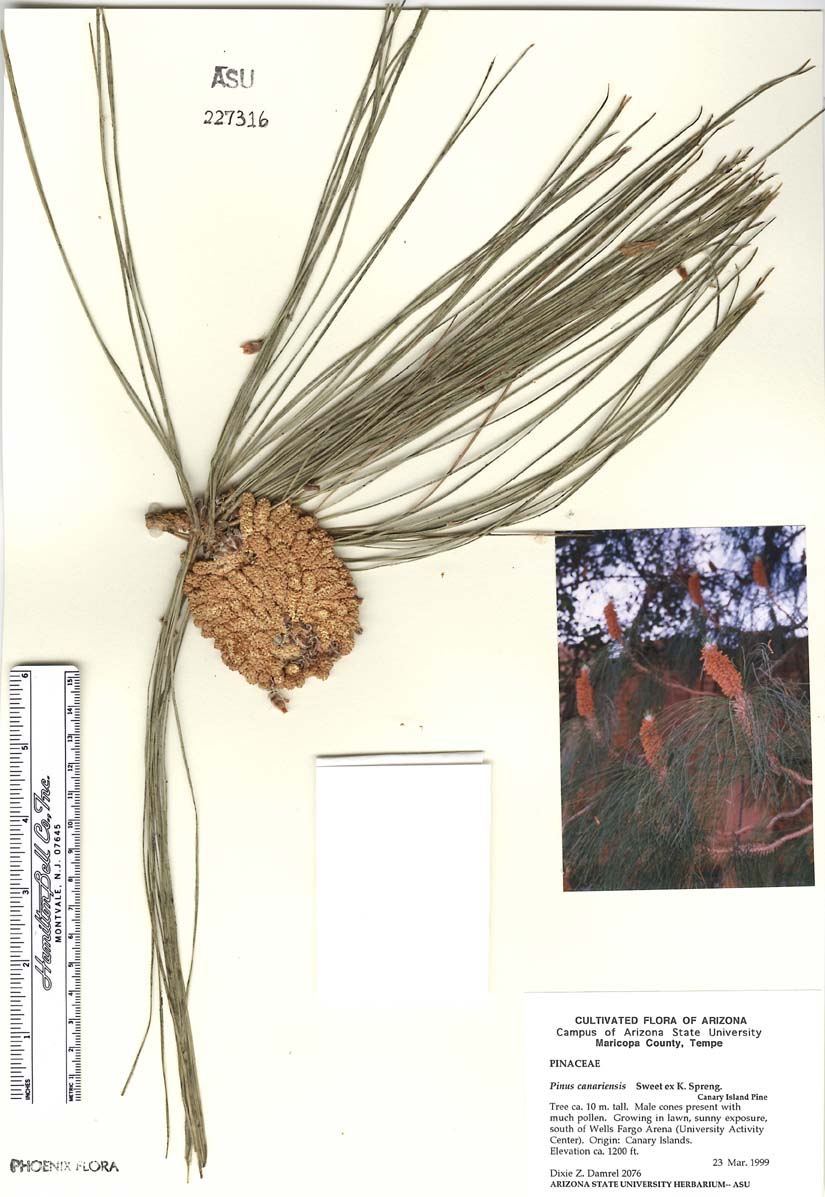Pinaceae
|
Pinaceae |
|
|
Trees (occasionally shrubs), evergreen (annually deciduous in Larix ), resinous and aromatic, monoecious. Bark smooth to scaly or furrowed. Lateral branches well developed and similar to leading (long) shoots or reduced to well-defined short (spur) shoots ( Pinus , Larix ); twigs terete, sometimes clothed by persistent primary leaves or leaf bases; longest internodes less than 1cm; buds conspicuous. Roots fibrous to woody, unspecialized. Leaves (needles) simple, shed singly (except whole fascicles shed in Pinus ), alternate and spirally arranged but sometimes proximally twisted so as to appear 1- or 2-ranked, or fascicled, linear to needlelike, sessile to short-petiolate; foliage leaves either borne singly (spirally) on long shoots or in tufts (fascicles) on short shoots; juvenile leaves (when present) borne on long shoots, scalelike; resin canals present. Pollen cones maturing and shed annually, solitary or clustered, axillary, ovoid to ellipsoid or cylindric; sporophylls overlapping, bearing 2 abaxial microsporangia (pollen sacs); pollen spheric, 2-winged, less commonly with wings reduced to frill (in Tsuga sect. Tsuga ), or not winged (in Larix and Pseudotsuga ). Seed cones maturing and shed in 1--3 seasons or long-persistent, sometimes serotinous (not opening upon maturity but much later: Pinus ), compound, axillary, solitary or grouped; scales overlapping, free from subtending included or exserted bracts for most of length, spirally arranged, strongly flattened, at maturity relatively thin to strongly thickened and woody (in Pinus ), with 2 inverted, adaxial ovules. Seeds 2 per scale, elongate terminal wing partially decurrent on seed body (wing short or absent in some species of Pinus ); aril lacking; cotyledons 2--12[--18]. The Pinaceae, with a fossil record extending back to the Cretaceous (C.N. Miller Jr. 1988), constitute a clearly defined natural taxon, the basic delimiting features of which are seen in the mature seed cones: bract-scale complexes consisting of well-developed scales that are free for most of their length from the subtending bracts, two inverted ovules on the adaxial face of each scale, and usually an obvious seed wing that develops from the cone scale. The 10 genera, too, are clearly defined. The cones of certain members of the Pinaceae remain on the tree and closed for several to many years until a stimulus (often fire) causes them to open and shed their seeds. This condition, known as serotiny (adjective, serotinous), is seen in various pines (e.g., Pinus attenuata , P . banksiana , P . contorta ). This primarily Northern Hemisphere family extends south to the West Indies, Central America, Japan, China, Indonesia, the Himalayas, and North Africa. The family is dominant in the vegetation of large regions including, in the flora area, forests of the boreal and Pacific regions, of the western mountains, and of the southeastern coastal plain. Only one species of the family, Pinus merkusii , crosses the equator (in Sumatra). Members of the Pinaceae are of major economic importance as producers of most of the world's softwood timber. Additionally, they are sources of pulpwood, naval stores (e.g., tar, pitch, turpentine, etc.), essential oils, and other forest products. All members of the family present in the flora, especially pines, are of varying importance to wildlife for food and cover. Many species, including most of the genera, are grown as ornamentals and shelter-belt trees and for revegetation. Most commonly seen in cultivation in the flora area are species of Abies , Cedrus , Larix , Picea , Pinus , Pseudotsuga , and Tsuga , each of these genera being represented by numerous cultivars. Keteleeria and Pseudolarix are mainly botanical garden subjects. Cathaya , the most recently described genus (1958), is apparently not yet in cultivation in North America. Among the vegetative features useful for identification of some genera of Pinaceae are the leaf scars. These are best observed on those portions of living branchlets from which leaves have fallen.
|
|
